Efficient transport in Northern Europe
RAILWAYS OF EUROPE - 18
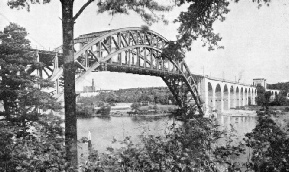
STEEL AND REINFORCED CONCRETE are widely used to-day for bridge construction on the Swedish State Railways. This illustration shows the Arsta Bridge which carries the railway over a river in the Stockholm suburbs.
THE railway conquest of the world embraces many romances of transportation under difficulties. In few corners of the globe, however, has the railway engineer raised such a wonderful monument to his skill and adaptability as in Sweden. There, even within the Arctic Circle, many luxurious passenger trains to-day speed along the electrified tracks that cut through the ice-fields and barren wastes of Northern Lapland. They demonstrate in a striking fashion the victory of man over nature, and open up to the outside world a stretch of territory once looked upon as practically impenetrable.
But little of the railway mileage of Sweden lies within the Arctic Circle, although these “farthest north” railways form an attractive section of the country’s transportation system. From north to south, the Swedish railways cover a distance of approximately a thousand miles, extending over several degrees of latitude. While at certain seasons some portions of track may be almost snowbound, and kept open for traffic only by the constant vigilance of the snow-plough gangs, in other more favoured districts railway operations may be proceeding under the pleasantest of climatic conditions.
The standard-gauge lines owned and operated by the Swedish government run to a length of approximately 4,250 miles, while there are also privately-owned standard-gauge railways having a mileage of 4,000. In addition to these 4 ft 8½-in gauge tracks, there are about 2,000 miles of privately-owned narrow-gauge railways, principally serving rural areas and acting as feeders to the main-line routes.
Construction of Sweden’s first railway began in 1850 by a company under government charter, and shortly afterwards the first section of the government railway between Stockholm and Gothenburg was opened for traffic. In general, the Swedish railways are single-track, double-track being usual only on the more important main lines. The weight of the rails employed varies from 67 to 82 lb per yard, although at the present time a good deal of somewhat heavier steel is being introduced.
As is common on most European lines, flat-bottomed rails are used, with steel soleplates between rail and sleeper, instead of the British chair. While on some of the Swedish routes every single foot of railway has had to be laid on shelves blasted out of solid rock, or else carried across rivers by expensive bridge works, in general railway construction costs have averaged less than in most continental countries. This is mainly because many of the Swedish landowners have made no charge for the laying of tracks over their property.
Because of the innumerable rivers to be crossed, Sweden possesses many notable bridge works on her railway system. At the outset most of the Swedish bridges were built of wood felled in the adjacent forests, and were mostly of short span. Later, arched stone bridges were introduced, but, the cost of these proving prohibitive, iron structures were used. Maintenance charges being heavy on this class of structure, attention was next turned to the possibilities of reinforced concrete, and to-day reinforced concrete is usually in favour. The new railway bridge across the Ore Elf (River) is claimed to be one of the longest railway bridges of reinforced concrete in the world.
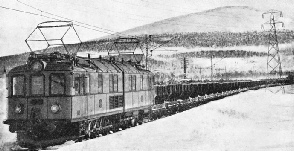 IRON ORE TRAIN on the Narvik-Lulea route. This section of the Arctic Circle line is electrically operated for 280 miles, and is one of the world’s most northerly railways. From Riksgransen on the border the line is controlled by the Norwegian State Railways.
IRON ORE TRAIN on the Narvik-Lulea route. This section of the Arctic Circle line is electrically operated for 280 miles, and is one of the world’s most northerly railways. From Riksgransen on the border the line is controlled by the Norwegian State Railways.
Swedish train signalling installations are, in the main, similar in design to those of Norway, Germany, and other neighbouring countries. Modern interlocking plants are provided at all the principal stations, and automatic block signalling on most main lines. The Swedish State Railways have attained a most enviable standard of safety. This is in a considerable measure attributable to the excellence of the signalling apparatus employed, and to the care and vigilance exercised by all concerned in the movement of trains.
Sweden possesses many excellent examples of imposing railway stations. Stockholm, Gothenburg, Malmo, and Uppsala are typical passenger stations. All are built on exceptionally commodious lines, and are admirably designed from the operating point of view. Sweden was one of the first European countries to recognize the value of an attractive city station in drawing business to the railway, and the salesmanship side of her railway undertaking has been extraordinarily well developed. Many of the Swedish station employees speak excellent English, and no pains are spared to make the lot of the traveller an unusually pleasant one.
Speed Restrictions
Steam locomotives in Sweden are mostly manufactured within the country itself, notably at the Trollhattan and Motala workshops; passenger and freight stock is built at Malmo, Kristianstad, and Arlof. The Swedish State Railways have centralized all their rolling-stock repairs at the Orebro workshops. For many years the steam locomotives have been constructed with superheaters, generally of the Schmidt type. The maximum speed permissible is ninety kilometres (fifty-six miles) an hour for steam-hauled passenger trains, and fifty kilometres (thirty-one miles) an hour for goods trains. British locomotive coal is largely utilized, but recently quantities of German coal have been imported.
Sweden claims to be the first country in the world to introduce the third-class sleeping-car, introduced in Great Britain a few years ago. The comparatively long distances to be traversed in the main-line services have popularized sleeping-car travel. Most of the passenger carriages in Sweden are of the bogie corridor type, with luxurious interior fittings. In many of the day cars exceptionally large windows are fitted, with the idea of improving passenger observation, these window's in some instances being of “Vita Glass.”
Passengers travelling by first-class sleeper are entitled to the use of a separate compartment. Two passengers are allocated to each second-class and three to each third-class sleeping compartment. In the Stockholm-Gothenburg-Malmo fast trains are saloon carriages furnished with comfortable arm-chairs, which are at the unrestricted disposal of the passenger, thus virtually giving Pullman service at no extra charge. In the dining-cars there are normally two separate sittings of one hour each for fixed-price meals, after which the service is according to the bill of fare.
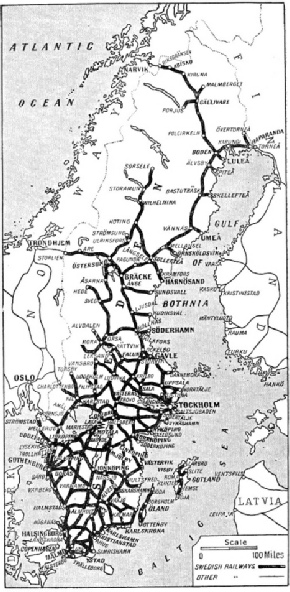
SWEDEN’S FIRST RAILWAY began in 1850 as a company under government charter. To-day the Swedish government owns about 4,250 miles of standard gauge track. There are also 4,000 miles of privately owned standard gauge and 2,000 miles of narrow gauge.
The principal railway routes in Sweden are the lines joining Stockholm with Gothenburg and Malmo, to the southwest, with a connecting link to Oslo, capital of Norway; that from Stockholm via Uppsala and Bracke to Trondhjem; and the “farthest north” railway link connecting Bracke with Boden and Narvik in the Arctic Circle. All these lines connect with Norway. The Stockholm-Gothenburg line, some 285 miles in length, is electrified throughout, while the Lulea-Narvik section of the Arctic Circle line also is operated by electricity. This electrified line, about 300 miles long, is in the most northerly railway operating in the world, after the Murmansk Railway, described in the chapter “Russia and Siberia”.
On the Stockholm-Gothenburg line electrification has proved a great success. The single-phase current system is employed (16⅔ cycles, 16,000 volts), and all passenger and freight trains are hauled by electric locomotives of uniform type drawing current from overhead conductors. The locomotives weigh 78 tons, and are of the 1-C-1 type with two gearings - one speed for fast passenger working, and the other for slow passenger and freight haulage. For express working, trains of 550 tons are hauled at an average speed of 46 and at a maximum speed of 65 miles an hour. The journey between Stockholm and Gothenburg takes between six and seven hours, including all stops.
Sweden is linked up with other European countries by an elaborate system of steamships and ocean-going train-ferries. Great Britain has for some years had experience of train-ferry operation for freight traffic between Harwich (Essex) and Zeebrugge, but there are not as yet any passenger-carrying train-ferries in service, although the Southern Railway intends to open up a passenger train-ferry between England and France.
The principal Swedish train-ferry service is that between Trelleborg and Sassnitz, in Germany. This line is served by four ferry-boats, two belonging to Sweden and two to Germany. These vessels, owned and operated by the State railways of the two countries, are claimed to be the largest passenger-carrying ferry-boats in the world, exceeding in size even the giant train-ferries of America. Each boat is capable of carrying 1,800 passengers. The two triple-expansion engines, having a maximum of 5,000 horse-power and a maximum speed of nearly 20 knots, enable the crossing from Sweden to Germany to be accomplished expeditiously. An icebreaker ferry is also engaged on this route.
The train deck of the Trelleborg-Sassnitz ferries is equipped with two railway tracks amidships, with a total unobstructed length of 550 ft. Since the tracks do not run for the entire length of the vessel, the landing is made by the stern of the ship, the landing-stages being so arranged that the lines can be speedily and safely connected up between ship and shore. Eight passenger cars of standard European design are carried on each ferry boat, while the equipment of the boats also includes smoking-rooms, ladies’ rooms, bathrooms, and cabins for a hundred passengers, all installed on ocean-going liner standards. Electric lighting is installed throughout, and heating is provided by a special hot-air arrangement.
Because of the operation of this important Baltic train-ferry, and the wisdom of all the principal European railway systems in operating to a standard track gauge of approximately 4 ft 8½-in, it is possible to run through trains and through carriages between Swedish towns and most of the leading European cities.
Without doubt the most interesting of all Swedish railways is the so-called “Iron Ore Railway”, which forms the connecting link between Sweden and Norway in the snowbound fastnesses of the Arctic Circle.
This line runs for seventy miles through the region of eternal snow, reaching a latitude of 68°25' N. It forms part of the through route previously referred to between Stockholm, Bracke, Boden, and Narvik. Between Stockholm and Narvik there is a through train daily in either direction. The run occupies some thirty-six hours, and the trains in this service are equipped with comfortable sleeping cars and efficient restaurant-cars. About one hour’s run from Stockholm lies the University centre of Uppsala, whence the route continues north past Krylbo, Ange and Bracke, into Norrland, a region of vast forests and mighty rivers. Beyond Bracke the route traverses the courses of two of Sweden’s most beautiful rivers - the Indal River and the Angerman River. The country gradually grows more level until the Arctic Circle is reached, and a brief halt is made at the station of Boden. Here steam gives place to electricity, and the electric trains speed on their course through the country of the Lapps, with their primitive farms and herds of reindeer.
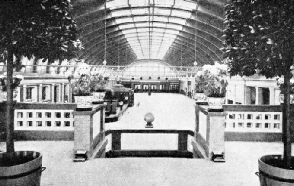
THE CENTRAL RAILWAY STATION at Stockholm, which was rebuilt in 1927. This photograph shows the main concourse of the building.
The extreme north is a land of contrasts. This is the land of the Midnight Sun - a fascinating stretch of territory, where the primitive civilization of the Mongolian Lapp is found side by side with wonderful examples of modern engineering.
It was the exploitation of the rich iron-ore fields in this area that led to its opening up by railway building, the two main mining centres in Lappland being Gallivare and Kiruna. The Gallivare deposits are estimated at 270,000,000 tons of ore, and the products of this area are shipped through the Swedish port of Lulea, and through the Norwegian port of Narvik.
Not many years ago Narvik did not exist; to-day it is a throbbing port, replete with the most modern equipment, and having an extensive trade. Iron brought Narvik into existence. In the heart of the vast Lapland wilderness beside Lake Luossoiarvis rises a towering hump. This is Kiruna, a great mountain of iron ore. It rivals even the huge iron storehouse of Gallivare, 60 miles to the south, upon which the steelworks of the Rhine once depended for their supplies. For the Kiruna ironfield good access to the sea was essential. Deliberations upon the huge issues at stake resulted in the decision to continue the Great Northern Railway of Sweden onwards from Gallivare through Kiruna and Riksgransen on the Norwegian-Swedish frontier to the coast at Narvik. The section from the seaboard to the frontier, known as the Ofoten Railway, forms part of the Norwegian State Railways system, while the eastern section, comprising the northern extension of the northern main line from Stockholm, belongs to the Swedish Government. Private enterprise was responsible for the inception of the project; a group of Anglo-Scandinavian financiers procured in 1883 the concession to construct a line from Ofoten Fjord to Lulea, at the head of the Baltic Sea, and formed “The North of Europe Railway Company, Limited”, subsequently known as “The Swedish and Norwegian Railway Company, Limited”, for this purpose. This concession was subsequently re-acquired by the two Scandinavian nations whose combined enterprise brought about the completion of the scheme.
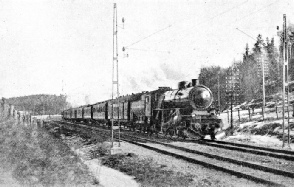
STEAM LOCOMOTION still plays an important part on Swedish railways despite extensive electrification. There are some 800 steam engines in use, most of which are of Swedish manufacture. English locomotive coal is largely used, but fuel is also imported from Germany.
Both divisions traverse the wildest, loneliest and most silent stretches of the peninsula, where the snow holds undisputed sway for the greater part of the year. Traffic is chiefly confined to the movement of the ore, although there is appreciable passenger traffic to and from the ironfields. In 1899 Kiruna was little more than a village. A few wooden shacks dotted the flats around the shore of the lake with a rough wagon-track or snow-road, according to season, forming the only means of communication with Gallivare, 60 miles to the south.
To-day Kiruna is an imposing town, with a ceaseless throb of industry in strong contrast to the silence of the wilderness around it. Toil throughout the hours of daylight is not surprising, since during midsummer the day lasts twenty-four hours. But to gain an adequate impression of Kiruna’s activity it should be visited in the depth of winter, when the nights are long, and the countryside is covered with its 16-ft blanket of snow. The face of the massive mountain has been carved into a flight of huge terraces stepped one above the other. Trains fuss to and fro incessantly along the benches, while strings of cars pass from crest to base bearing the valuable ore for transhipment to the railway. The benches, with their serried rows of electric lights illuminating the working faces, where gigantic tools are labouring, resemble streets. The prevailing blackness of the mountain is punctured in all directions and in seemingly endless succession by vivid flashes of flame from the detonated blasting charges. The sustained drone of machinery and of moving trains is accompanied by the deep sullen roar of the rock-splitting explosives.
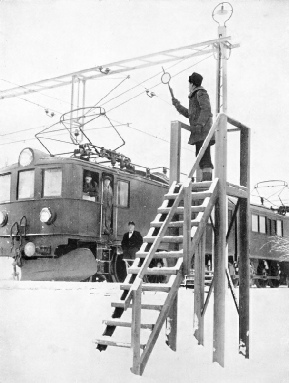
ON THE ROUTE OF THE LAPLAND EXPRESS. This is the name familiarly applied to an express train of the Swedish State Railways which travels northwards from Stockholm with a through coach for the Riksgransen railway, in the extreme north of Sweden, well within the Arctic Circle. The Riksgransen Railway was constructed under considerable difficulties, but the enemy of ice and snow has been faced and defeated. In this photograph a station-master in the far north is signalling to the driver on a special platform erected for use at times when the snow is deep.
The port of Lulea is ice-bound for some six months out of the twelve. At Kiruna the deposit is estimated to contain approximately 758,000,000 tons of iron ore, a prodigious figure which augurs well for the future prosperity of railways in this corner of the continent.
Electrification of the Arctic Circle Railway began so long ago as 1910. By 1923 the electrification had been completed throughout from Lulea to Narvik. The original electric locomotives employed by the Swedish State Railways on this 300-miles stretch of railway were of two main types, one for passenger train haulage, and the other for the drawing of the iron ore trains. The passenger locomotives were 46 ft long, had driving-wheels of 5 ft diameter, and a tractive effort of 12,320 lb. The driving motor was rated at 1,000 horsepower, the total weight was 82 tons, and the highest speed attained was 62 miles an hour. The electric locomotives utilized for iron ore train haulage were formed in two sections of equal length, the length overall being 61 ft. The diameter of the driving-wheels was 4 ft, and the tractive effort 36,960 lb. The two motors were rated at 850 horsepower, the total weight of the locomotive in working order was 140 tons, and a maximum speed of 37 miles an hour was attained.
The iron ore trains consist of forty wagons as a general rule, with a guard’s van and electric locomotive, and on the steepest gradients speeds of from 18 to 22 miles per hour are maintained. Two insulators, each supporting a 6mm steel wire, are fitted at the top of the contact line poles. This wire is employed to carry 60-cycles single-phase current of 10,000 volts tension to stations and workshops along the track.
Underground Power House
The current is transformed to a lower voltage in track-side sub-stations for train operation. Automatic sub-stations solve the labour problem in remote areas.
Electric current for the entire railway is produced at the Porjus power station by four single-phase generators. Each generator delivers a continuous output of 6,000 kVA, the maximum output being 10,000 kVA. The required power is generated at 4,000 volts tension, 15 cycles, transformed to 80,000 volts for feeding the transmission lines. The total length of these lines is 315 miles, and they supply current to fifteen transformer stations, placed about twenty miles apart. Transformer stations have been erected at thirteen suitable points on the Swedish portion of the Arctic Circle Railway, and there are also transformer points at Narvik and Hundalen on the Norwegian section. Single-phase current of 15 cycles frequency and 16,000 volts tension is employed for the contact lines.
The Porjus power plant of the Swedish authorities is one of the largest in Europe, being equipped for 82,500 horsepower. As a protection against climatic conditions, the machine-room is installed at a depth of 165 ft below ground level, a portion of the mountain-side having been blasted away for this purpose. Wonderful increase in operating efficiency has been secured by the electrification of the Arctic Circle Railway. The employment of electricity in the place of steam has made it possible to increase the weight of trains some forty to fifty per cent, while running time has been cut by one-half. The capacity of the line has thus been increased nearly three times. The electric locomotives cover 60,000 miles annually in handling iron ore, and the passenger locomotives 100,000 miles a year.
The greatest attraction for the traveller over this most wonderful of the world’s railways is, of course, the far-famed Midnight Sun. For all thinking folk, however, the marvel of the Midnight Sun is challenged by the marvel of the railway engineer’s and operating man’s accomplishments in this “farthest north” section of the Swedish State Railways system.
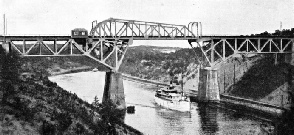
THE SODERTALJE BRIDGE, near Stockholm. This structure, which carries an electrified section of line, is of the rolling lift type. The central span is pivoted on the left-hand side and can be raised when it is necessary for big ships to pass beneath the railway.
You can read more on
“Electrification in Europe”
and
“The Railroads of Norway”
and
“Transport in Finland”
on this website.
You can read more on the
Iron Ore Railway
in Wonders of World Engineering



 IRON ORE TRAIN on the Narvik-
IRON ORE TRAIN on the Narvik-



